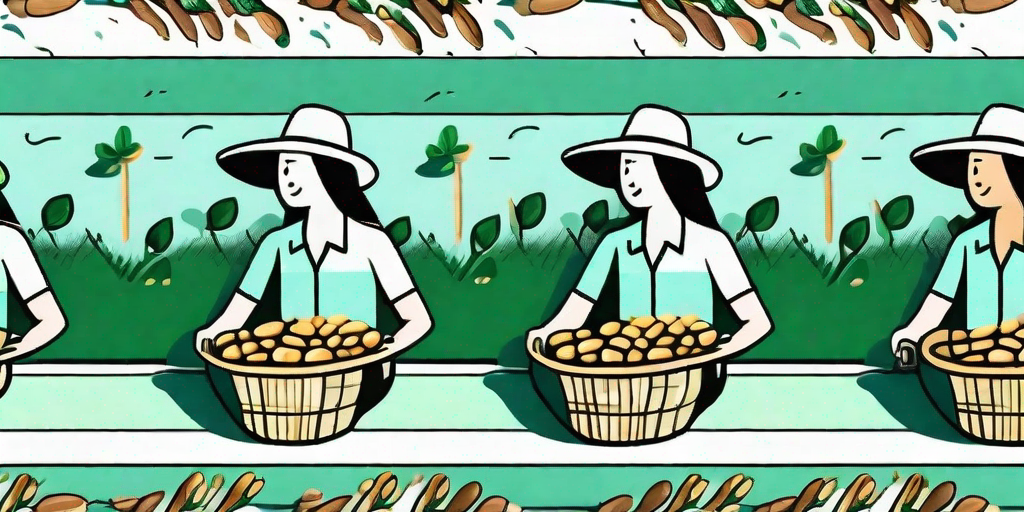
Ah, the humble peanut. A nut that's not really a nut, but a legume. A tiny treasure that burrows underground, shying away from the world until it's time to shine. Whether you're a seasoned farmer or a green-thumbed newbie, this guide will help you achieve peanut picking perfection. So, let's dig in, shall we?
The Peanut Plant: A Brief Introduction
Before we delve into the nitty-gritty of peanut picking, let's take a moment to appreciate the plant that makes it all possible. The peanut plant, or Arachis hypogaea if you want to get technical, is a fascinating specimen. It flowers above ground, but fruits below. A bit of an oddball, but we love it nonetheless.
Native to South America, the peanut plant has spread its roots across the globe, thanks to its versatile nature and nutritional value. It's a hardy little thing, capable of thriving in a variety of soil types. But enough about the plant, let's move on to the star of the show - the peanuts.
When to Pick Peanuts
Timing is Everything
Like any good thing in life, peanuts require patience. They're not a plant-it-and-forget-it kind of crop. Oh no, these little legumes demand your attention and care. But when is the right time to pick peanuts, you ask? Well, it all depends on the variety and the weather.
Typically, peanuts are ready for harvest 120 to 150 days after planting. But don't take our word for it. The best way to know if your peanuts are ready is to pull up a plant and check the pods. If they're a lovely golden brown, it's time to get picking.
Weather Woes
Weather plays a crucial role in peanut picking. Too much rain can cause the peanuts to rot, while too little can make them hard as rocks. The ideal weather for peanut picking is a dry, sunny day. So keep an eye on the forecast and plan your harvest accordingly.
Remember, Mother Nature is unpredictable. If the weather isn't cooperating, don't despair. Just cover your peanuts with a tarp and wait for a sunny day. Patience is key when it comes to peanut picking.
How to Pick Peanuts
Tools of the Trade
Now that we've covered the when, let's move on to the how. Picking peanuts is a labor of love, requiring a few simple tools and a lot of elbow grease. You'll need a spade or garden fork, a bucket, and a pair of sturdy gloves. And don't forget the most important tool of all - your hands.
Start by loosening the soil around the plant with your spade or fork. Be careful not to damage the peanuts. Once the soil is loose, gently pull up the plant, shaking off any excess soil. Then, pick the peanuts off the plant and place them in your bucket. Easy peasy, peanut squeezy.
The Art of Drying
Once you've picked your peanuts, the job isn't over. The peanuts need to be dried before they can be stored or eaten. Spread them out in a single layer in a dry, well-ventilated area. This could be a shed, a garage, or even a covered porch. Leave them to dry for about two weeks, turning them occasionally to ensure even drying.
After two weeks, test a peanut to see if it's dry. It should snap cleanly in half. If it bends, it needs more time. Once your peanuts are dry, they can be stored in a cool, dry place for up to a year. Now that's what we call a bountiful harvest!
Common Peanut Picking Problems
Pests and Diseases
Like any crop, peanuts are susceptible to pests and diseases. Common culprits include aphids, thrips, and the dreaded peanut root-knot nematode. Regularly inspect your plants for signs of damage and take action at the first sign of trouble.
Diseases such as leaf spot and rust can also wreak havoc on your peanut crop. To prevent these, ensure your plants have plenty of space for air circulation and avoid watering from above, as this can spread disease.
Poor Yield
If your peanut harvest is less than stellar, don't despair. There could be several reasons for this. Maybe the soil isn't rich enough, or the plants didn't get enough water. Perhaps the weather was too hot, or too cold. The key is to learn from your mistakes and try again next year. After all, Rome wasn't built in a day, and neither is a bountiful peanut harvest.
FAQs
- Can I grow peanuts in containers?
Absolutely! Peanuts are quite adaptable and can be grown in large containers. Just make sure the container is deep enough for the peanuts to develop.
- How many peanuts can one plant produce?
On average, a peanut plant can produce 40 to 50 pods, each containing 1 to 3 peanuts. That's a lot of peanuts from one little plant!
- Can I eat the peanuts right after picking?
Technically, yes. But they won't taste very good. It's best to dry the peanuts first to enhance their flavor and make them easier to shell.
So there you have it, folks. A comprehensive guide to peanut picking perfection. Now go forth and harvest!











